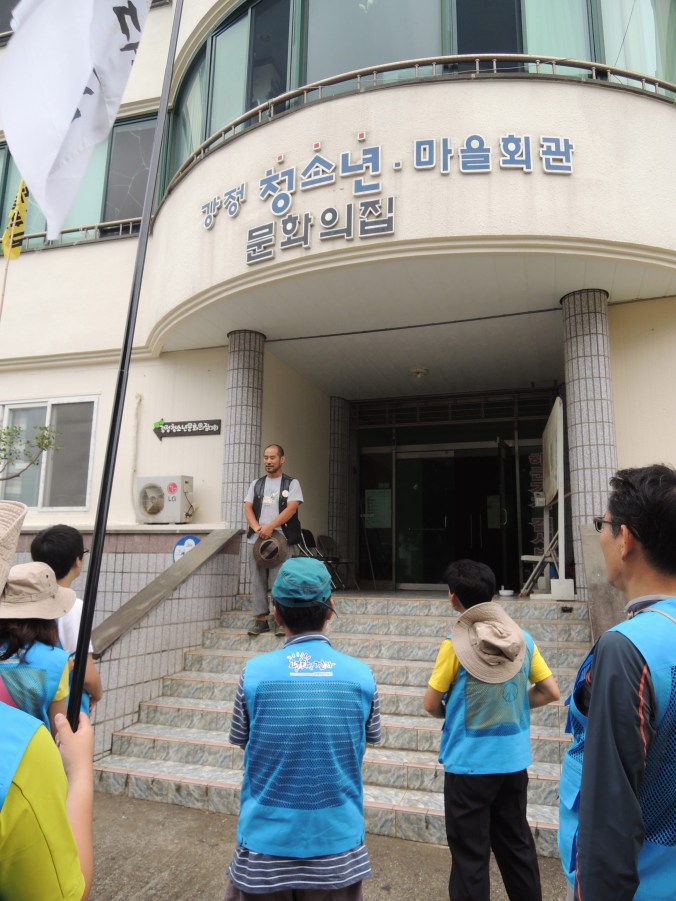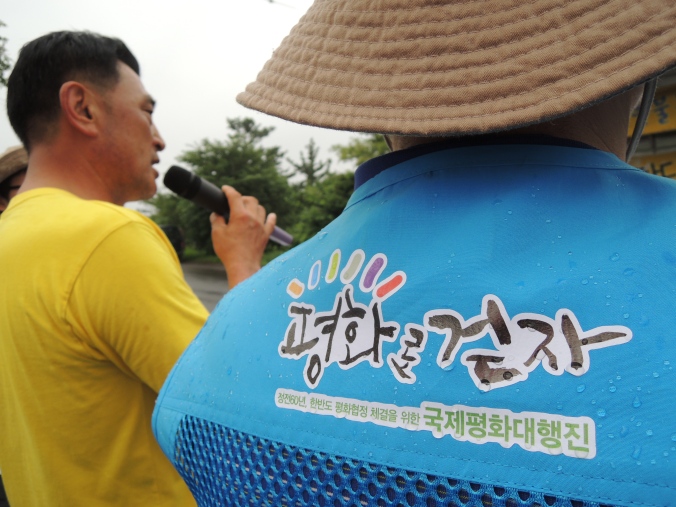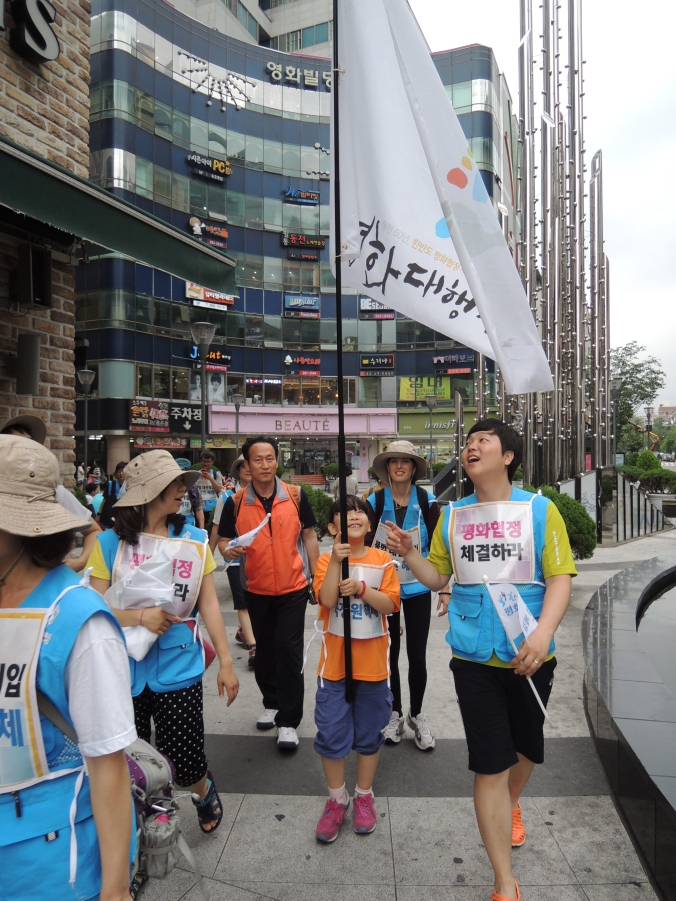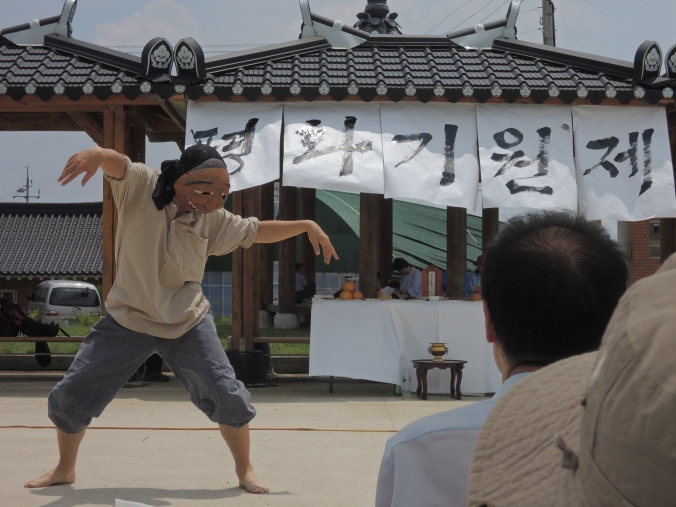By Dae Han Song
The International Peace March started July 3rd at Gangjeong Village and continues until July 27th – the 60 year anniversary of the Armistice Agreement – when rallies will be held in front of the US Embassy and military bases in Seoul calling for a peace treaty to finally conclude the Korean War. Along the way, marchers will visit sites of the Korean War and ongoing struggles to reflect upon the connections between war, military spending, and division to militarization, social welfare, and political repression.
Day 1
The cultural night before the start of the International Peace March. Melodies of struggle floated upon warm tropical breezes. (To watch and listen to the performances, click here)
The first day of marching starts at Gangjeong Village, currently a site of struggle against construction of a naval base. (Visit the Save Jeju Now site for more information). Villagers and peace activists in South Korea and around the world oppose the naval base construction not only due to the destruction of villager’s livelihoods and the environment, but also due to its potential use as the site of a missile defense system. Located approximately 300 miles from Shanghai, this future naval base would likely house a US missile defense system to neutralize China’s missile capabilities. Above, the President of the Task Force Against Construction of the Jeju Naval Base updated us on the struggle. Due to the various fines levied against the protesters by the government, villagers are considering selling their community building to pay for outstanding fines.
With construction taking place behind us across a body of water, a member of the Unified Progressive Party relates the current status of the naval base construction. As the budget balloons past the projected cost, only 30 percent of the naval base has been completed because typhoons continue to delay and destroy construction.
“Peace is the Way”
Protesters have created sites of occupation and art all across the construction site calling for peace
and a halt to the naval base.
After occupations and direct resistance, the construction company Samsung erected barriers all along the site. The press conference launching the march took place at the construction site entrance.
The mayor of Gangjeong Village calls for peace at the press conference, saying, “The struggle in Gangjeong is directly connected to the struggle for a peace treaty.” The marcher’s vest reads, “Walking Towards Peace: An International Peace March to end the 60-year armistice agreement and establish a peace treaty.”
Marching while some chat and others upload photos and updates on social networking sites.
A banner reads “Oppose the Naval Base to the Death”
A moment of silence and reflection in honor of those killed during the April 3rd Jeju Uprising. Protests had erupted in Jeju against the separate 1948 elections in North and South Korea. Subsequent police repression and torture, along with the deployment of the right-wing Northwest Youth Corps, later sparked a guerrilla uprising. The police and military suppressed the guerrillas in 1949, in the process killing 25,000 to 30,000 islanders (1 in every 5 islanders) and destroying 230 villages (more than half). While such momentous events are recorded in official history, they are mostly absent from the general public’s consciousness. Moments such as these are reminders of the tragedies and horrors of war and testimonies for the need for peace.
The Korea Committee for the Preparation of State Construction was an organic body established for creation of an independent state immediately following the end of Japanese occupation. However, these autonomous state-construction efforts were shunned by the US, whose separate state-formation process revolved around Syngman Rhee and former Japanese collaborators. The orange areas on the map indicate cities and villages governed by people’s committees.
The grave sites of those killed in the April 3rd Uprisings.
One of the delegation – a netizen who traversed South Korea multiple times – brings along Che’s spirit.
Day 3
A cancelled rally offers the opportunity to practice our movement song and dance.
Marching in Changwon City.
Changwon City emerged and developed out of the surrounding industrial complexes and contains
a strong working class character.
Making new friends along the way
Members of local branches of Korea Woman Solidarity pump their fists while chanting for a peace treaty.
Day 4
Two surviving family members of guerrilla fighters pay their respects.
The letters above the altar read, “Prayer Ceremony for Peace.”
The ceremony was held at the base of Jiri Mountain to honor the guerrillas who fought against Japanese colonialism, and the Synghman Rhee government thereafter.
Family members of the deceased, peace marchers, and participants hold up a cloth path as a shaman
sends off the spirits of those killed in the Jiri mountains.
A Korean masked dancer plays a villager snatched from an idyllic existence and thrown into war.
The guerrilla stronghold of Jiri Mountain looms behind the ceremony site.
Nourishing our bodies with vitamin C tablets to stay healthy.
Clearly still healthy and full of energy, but still only the 4th day out of 21.
The grave site of the victims of the Sancheong-Hamyang Massacre in 1951. Seven hundred and five innocent villagers were killed as part of the army’s 11th division, 9th regiment, 3rd battalion’s efforts to liquidate communist guerrillas
on Jiri Mountain.
The author participated in the 21 day march for 4 days and 3 nights.























